All about spray guns

Learning all about spray guns can be of great benefit. But first you need to find out what the device and types of such a technique are, how to choose a spray gun for paint from the main ratings. We'll have to further explore low pressure spray guns and other models.


Features and purpose
Already from the very name "spray gun" one can draw a key conclusion about the essence of this device. This abbreviated name denotes paint spray guns... Compared to traditional methods of manual staining, such devices work much more accurately and more conveniently. The designers make sure that all the regulators and other components necessary for normal use are provided. The sprayer works for a long time without major overhauls thanks to the well-thought-out stock of spare parts. Those who have tried such a device in action at least once will never say that ordinary rollers and brushes are more convenient.
Modern spray guns not only save energy. They are much more productive than painting by hand, and can work on large surfaces, applying dyes of various compositions to them.
What is important, if the technology is observed, it will not be difficult to apply paint in a uniform layer. Structurally, such a device can be implemented differently.


But there are always general basic requirements:
-
the lightness of the machine and its individual parts;
-
minimal fatigue of painters during work;
-
high anti-corrosion performance;
-
use of spray heads of various sizes, which allows varying processing modes.

In any case, the paint also passes through the filter. Its use eliminates the clogging of the ink head. The basic principle of operation of a spray gun can be expressed in spraying:
-
airless;
-
pneumatic;
-
in a mixed way.
When choosing an airless or combined system, it will be possible to reduce the consumption of the coloring composition per unit of time. Such systems are also quite efficient.
But you need to understand that only experienced professionals will be able to use them so that there is no blurring.

Beginners are more likely to use hand-held pneumatic machines. Their simplicity and lightness, however, turns into low productivity in the end.
And also it is necessary to take into account how the coloring mixture enters the spray unit. This can happen:
-
from the upper container;
-
from the bottom tank;
-
under pressure from the supply system;
-
from the side paint accumulator.
Until a few decades ago, spray guns were used only by professionals. But the situation has changed a long time ago - there are coloring devices for home use.

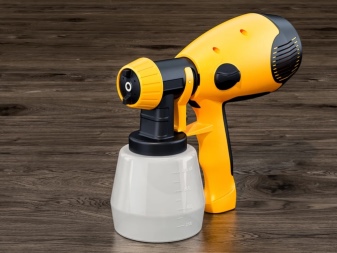
Simple models turn out to be quite convenient. Such devices, in addition to the actual staining, are used for:
-
whitewashing ceilings;
-
applying a primer;
-
spraying varnish;
-
removing wallpaper;
-
pest control of ornamental and field plants;
-
applying anti-corrosion compounds;
-
confectionery manipulations.



Views
Pneumatic
This is a classic look for a spray gun.... This design was developed before other options. It is noted that it allows you to work quickly, and, moreover, without loss of quality. The technology is very simple: first, the paint and varnish material is broken into separate particles, and then they form a kind of torch from them.In addition to traditional high pressure spray guns (otherwise called conventional systems), there are low pressure devices; in the latter case, there is still a difference in volume.
With all the advantages of pneumatics, a lot of dye is sprayed outside the treated surface. Reducing this amount is a challenge that engineers are constantly struggling with.
It is known that pneumatic spray guns were used in the first third of the twentieth century. But it is curious that the very first version was developed for the purpose of purely medical use. It is only relatively recently that low pressure systems have emerged that are more economical than "conventional" technology.

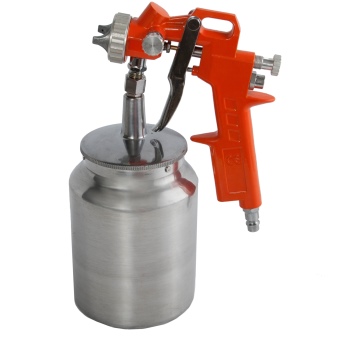
Mechanical
Such devices are also necessary. They are used without connection to the compressor, as in the previous case, and an electric drive is not required. The displacement of the liquid and its release to the desired surface is carried out by the action of a hand pump. This technique is relatively compact and autonomous, and can be used even where other devices are ineffective. Inside the case are hidden:
-
suction and discharge unit;
-
cylindrical block;
-
plunger pump;
-
suction and delivery hoses.
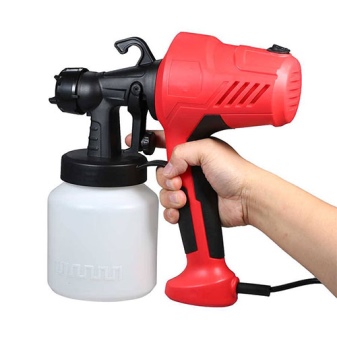

Electrical
Speaking about the methods of spraying paints and other substances, it would be strange to ignore their distribution with the help of an electric motor. Electric spray guns are capable of operating both air and airless. Among them, there are both relatively compact hand-held models and painting stations. In the second case, the drive power is noticeably higher, as is the performance. But the sizes do not differ so much.

Top brands rating
Start an overview of spray guns pertinently from the model BOSCH PFS 5000 E. This is an electrical device, the body of which resembles a three-dimensional triangle. Typical current consumption is 1.2 kW. Quick cleaning available and equipped with 3 spray heads. Significant weight and serious noise are serious drawbacks.
Whether such problems are compensated for by adjusting the supply of air and paint, it is up to the buyers to decide.

Among the manufacturers of professional industrial and construction spray guns, technology stands out Wagner... It is suitable for complex jobs. There is also a household segment among the Wagner assortment. Products of this brand emit a relatively small aerosol cloud (thanks to innovative technology). The service life of the devices is quite long.


Adherents of proven and relatively simple models of a purely mechanical nature should give preference to consoles KSOM... This Belarusian brand has been used for a long time.
The manufacturer deliberately refuses to manufacture high-tech devices.

Among the budgetary Chinese spray guns are:
-
Hilda;
-
DEKO;
-
Iwata;
-
TASP;
-
Osioc.
In Italy, sprayers are made by Walcom, Asturomec, Foxweld. If we talk about manufacturers from other countries, then noteworthy are:
-
Patriot (USA);
-
Ryobi (Japan);
-
Russian brands "SPETS" and "Caliber".
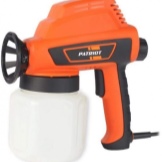


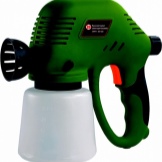
Criterias of choice
It is quite possible to choose mechanical (they are also manual) spray guns for home use. Such systems will perfectly cope with simple tasks - whitewashing walls or treating trees in the garden. But painting any large surface with such a technique is already quite painful. You can not count on accuracy when performing work. True, the "mechanics" usually serve for a long time.
Full-fledged construction and repair work, especially for large areas, is more correctly performed with a pneumatic spray gun. In this case, attention should already be paid to the use of compressors and receivers, their characteristics, as well as controls. The advantage of modern pneumatics is that it is well suited even for thick paint and varnish on wood, for other viscous substances.
High pressure systems paint quickly and fairly smoothly, and are inexpensive.Even a significant spread of paint to the side does not reduce their popularity in the household and professional segments.


But experienced painters usually prefer the HVLP variant, which is large in volume and designed for low pressure. It will transfer 60-65% of the dye mixture exactly to the surface to be painted. However, one cannot do without a high-quality compressor that supplies thoroughly cleaned air. In skillful hands, such a machine is used to paint on metal, on enamel or on rust. In the auto repair and industrial spheres, the LVLP type is in demand, which is more expensive than others, but allows transferring up to 80% of the required substance to the painted surface.
For electric sprayers, performance is directly related to the power of the motor. For everyday work in everyday life, it is quite enough, according to experts, 700 watts. Decorative painting is often carried out with 200-watt models. They are suitable for stenciling and painting on glass substrates. The speed of dyeing is usually correlated with the amount of paint emitted per minute.


Air machines are good due to the formation of an even and solid layer. It is easy to adjust the power according to your needs. However, the turbine will be quite loud. Airless technology uses a piston pump. Such a device is unlikely to paint large objects, but it will complete a professional sheet or garage door.
It is important to pay attention to the mass of such models. If the spray gun contains a portable pump, it may well weigh up to 5 kg. The simplest versions (1-1.5 kg) are suitable for delicate work for a long time. They are often used to decorate picture frames.
The intensity of the spray paint is determined by the cross-section of the nozzle. Enamels, varnishes and liquid dyes are fed through a hole 0.13-0.17 cm in size.For soil, putty mixtures and thick paint, a channel of at least 0.18 cm is needed. To make the machine more versatile, it is often equipped with replaceable attachments.
An alternative solution is to adjust the nozzle cross-section.

Workshops and airbrushing enthusiasts should pay attention to the comfort of the handle. In this case, ease of grip and responsiveness to manipulations are very important. Advanced connoisseurs choose models by design. It is important to consider the chemical composition of the paint.... For example, oil paint typically has a high viscosity, and therefore has to be used in a special way.
Water-based formulations are also quite viscous, but at the same time they are also very sticky. It is worth noting that high-end equipment can confidently work with almost any dyes.... Nevertheless, it is recommended to discuss this point in advance. Conventionally, a spray gun can also be considered a nozzle for a spray can with an aerosol mixture. Despite its limited performance, such a device at least keeps your hands clean.


Usage Tips
It is worth considering that the spray gun should be used very carefully. All surfaces for painting and other types of processing are prepared in advance. Metal and stone should be degreased. The viscosity of the paint is also selected individually. It can be varied by adding a solvent.
Before using a new apparatus or an unusual paint, a test must be performed. It is necessary to see if the dye is bubbling, whether it is evenly applied. It must be remembered that electrical and pneumatic systems are sources of increased danger. When working with them basic precautions must be followed.
How to set up a specific device is clearly described in the attached instructions. It also describes how to rinse it after the end of work.

Coloring is carried out from the angle of the planes. Move the apparatus from left to right. Each strip is applied below the previous one, however, covering it by 50%. When painting the walls, the stripes should go 10-12 cm on top of each other sequentially.It is very simple to avoid smudges when working with a spray gun - you just need to start from the edges, and only then move on to horizontal planes.
Only then can you paint over everything together - horizontals and edges. Inexperienced painters do things differently, which is why they run into problems. If streaks do appear, they will have to be removed or sanded off. Good results are obtained only by staining in 2 layers. The second is done only after the initially applied mass has completely dried.
If it is decided to paint the ceiling, it is necessary to issue a jet no longer than 70 cm. Only in this case the dye will be applied uniformly. The paint should be sprayed at a 90 degree angle to the surface. Circle work is recommended. As with walls, 2 layers must be applied to the ceiling in succession.

The wood is pre-treated with varnishes, primers and other preparatory materials. Metal surfaces are pretreated with solvents and washed with warm water.
If the areas are damaged, they must be putty. Move the spray gun slowly and without jerking. Various elements are colored from all sides.
Hammer paints can only be applied with professional spray guns equipped with a compressor. The nozzles must have a large cross section. The dye is diluted with xylene or solvent. Hammer paint is applied strictly in one pass, by creating overlapping stripes. This can be done in 1, 2 or 3 layers of your choice.















The comment was sent successfully.